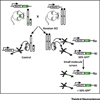Rett Syndrome: Crossing the Threshold to Clinical Translation
- PMID: 26830113
- PMCID: PMC4924590
- DOI: 10.1016/j.tins.2015.12.008
Rett Syndrome: Crossing the Threshold to Clinical Translation
Abstract
Lying at the intersection between neurobiology and epigenetics, Rett syndrome (RTT) has garnered intense interest in recent years, not only from a broad range of academic scientists, but also from the pharmaceutical and biotechnology industries. In addition to the critical need for treatments for this devastating disorder, optimism for developing RTT treatments derives from a unique convergence of factors, including a known monogenic cause, reversibility of symptoms in preclinical models, a strong clinical research infrastructure highlighted by an NIH-funded natural history study and well-established clinics with significant patient populations. Here, we review recent advances in understanding the biology of RTT, particularly promising preclinical findings, lessons from past clinical trials, and critical elements of trial design for rare disorders.
Keywords: MECP2; clinical trials; epigenetics; gene therapy; neurodevelopmental disorders; preclinical models.
Copyright © 2016. Published by Elsevier Ltd.
Figures



References
-
- Amir RE, et al. Rett syndrome is caused by mutations in X-linked MECP2, encoding methyl-CpG-binding protein 2. Nat. Genet. 1999;23:185–188. - PubMed
-
- Gadalla KK, et al. MeCP2 and Rett syndrome: reversibility and potential avenues for therapy. Biochem. J. 2011;439:1–14. - PubMed
-
- Weng SM, et al. Rett syndrome: from bed to bench. Pediatr. Neonatol. 2011;52:309–316. - PubMed
Publication types
MeSH terms
Grants and funding
- R01 MH093372/MH/NIMH NIH HHS/United States
- R01NS085093/NS/NINDS NIH HHS/United States
- R01 NS085093/NS/NINDS NIH HHS/United States
- 091580/WT_/Wellcome Trust/United Kingdom
- R01MH093372/MH/NIMH NIH HHS/United States
- R01HD036655/HD/NICHD NIH HHS/United States
- G0800401/MRC_/Medical Research Council/United Kingdom
- R01 HD036655/HD/NICHD NIH HHS/United States
- R01 NS057398/NS/NINDS NIH HHS/United States
- R01NS057398/NS/NINDS NIH HHS/United States
- 107930/Z/15/Z/WT_/Wellcome Trust/United Kingdom
- P30 NS045892/NS/NINDS NIH HHS/United States
- R21 NS087132/NS/NINDS NIH HHS/United States
- 092076/WT_/Wellcome Trust/United Kingdom
LinkOut - more resources
Full Text Sources
Other Literature Sources
Medical
Miscellaneous

